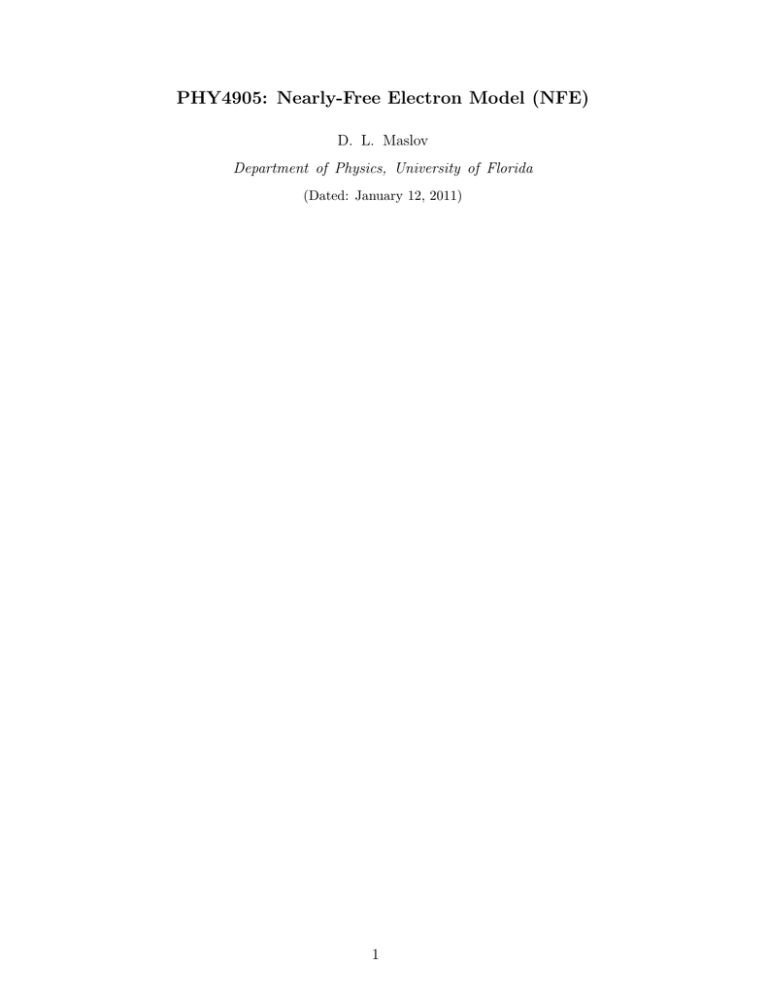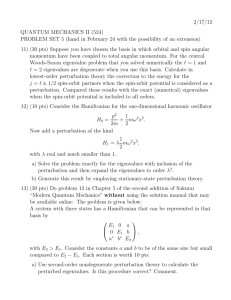PHY4905: Nearly-Free Electron Model (NFE) D. L. Maslov 1
advertisement

PHY4905: Nearly-Free Electron Model (NFE)
D. L. Maslov
Department of Physics, University of Florida
(Dated: January 12, 2011)
1
I.
REMINDER: QUANTUM MECHANICAL PERTURBATION THEORY
A.
Non-degenerate eigenstates
This is a quick review of how the perturbation theory is applied to a system with nondegenerate eigenvalues. Consider a Schroedinger equation
(H0 + U )ψ = Eψ,
(1.1)
where U is a small perturbation. Suppose that H0 has a discrete spectrum and none of its
eigenfunctions are degenerate
H0 ψn(0) = En(0) ψn(0) .
(1.2)
Suppose we want to find corrections to the energy and eigenfunction of state n:
(1)
En = En(0) + En(1) ,
(1.3)
ψ = ψn(0) + ψn(1) ,
(1.4)
(1)
where En and ψn are of the first order in U. Now, substitute Eqs. (1.3,1.4) into (1.1), take
into account Eq. (1.2), and neglect all terms which are order of U 2 :
(H0 + U ) ψn(0) + ψn(1)
= En(0) + En(1)
ψn(0) + ψn(1)
H ψ (0) +H0 ψn(1) + U ψn(0) + U ψn(1) = En(0) ψn(0) + En(1) ψn(0) + En(0) ψn(1) + En(1) ψn(1)
| {z }
| {z }
| 0{zn }
order U 2
(0)
0ψ
=En
n
order U 2
H0 ψn(1) + U ψn(0) = En(1) ψn(0) + En(0) ψn(1)
(1.5)
Since the eigenfunctions of the unperturbed problem form a complete basis, any function,
(1)
including the correction to the eigenfunction do the perturbation, ψn , can be expanded
over this basis as
ψn(1) =
X
(0)
cm ψm
.
(1.6)
m6=n
The m = n term is already included in the definition of the first-order correction, Eq. (1.4).
Coefficients cm , which determine the admixtures of the other states to the unperturbed
state n, arise only because of the perturbation and, therefore, are small as long as U is
small. Subsititing Eq. (1.6) into Eq. (1.5) we obtain
X
(0) (0)
cm Em
ψm + U ψn(0) = En(1) ψn(0) + En(0)
X
m6=n
m6=n
2
(0)
cm ψm
.
(1.7)
h
i∗
(0)
Now we multiply this equation by ψn
and integrate over the coordinate, taking into
i∗
h
R
(0)
(0)
account that dx ψl
ψm = δl,m . This yields
En(1) = Unn ,
where
Ulm =
Z
dx
h
(0)
ψl
i∗
(0)
U ψm
.
Thus the first-order correction to the energy of state number n is just an expectation value of
the perturbation potential in this state. In order to find the correction to the eigenfunction,
i∗
h
(0)
multiply Eq. (1.7) by ψk
with k 6= n. This yields
(0)
ck Ek + Ukn = En(0) ck
or
ck =
and
ψn(1) =
Ukn
(0)
(0)
En − Ek
Ukn
X
(0)
k6=n En
−
(0)
Ek
(0)
ψk
(1.8)
Likewise, one can find second-order corrections
En = En(0) + En(1) + En(2)
(1.9)
ψn = ψn(0) + ψn(1) + ψn(2) .
(1.10)
Substituting these expansions again into Eq. (1.1), taking into account (1.2) and (1.5), and
neglecting terms of order U 3 (but keeping terms of order U 2 ), we find
H0 ψn(2) + U ψn(1) = En(2) ψn(0) + En(1) ψn(1) + En(0) ψn(2) .
(1.11)
(0)
The second-order correction to the eigenfunction can also be expanded over the set of ψn
ψn(2) =
X
(0)
dm ψm
.
m6=n
Substituting this expansion into (1.11) and using (1.8), we obtain
X
m6=n
(0) (0)
dm Em
ψm +U
X
Umn
(0)
m6=n En
ψ (0) = En(2) ψn(0) +Unn
(0) m
− Em
3
X
Umn
(0)
m6=n En
ψ (0) +En(0)
(0) m
− Em
X
m6=n
(0)
dm ψm
.
h
i∗
(0)
Multiplying this equation by ψn
and integrating, we obtain
En(2) =
X Unm Umn
(0)
(0)
.
(0)
.
m6=n En − Em
∗
If U is a real function, Umn = Umn
. Therefore,
En(2) =
X
|Unm |2
(0)
m6=n Em − En
(1.12)
Notice that both the 1st order correction to the eigenfunction, Eq. (1.8) and the 2nd
order correction to the eigenenergy, Eq. (1.12), diverge if the at least two of the states are
(0)
(0)
degenerate, i.e., if Em = En . In this case, the perturbation theory constructed in this
section diverges, and one has to select the eigenfunctions of the zeroth order in a different
way. This is done in the next section.
B.
Degenerate eigenstates
Now suppose that some eigenstate of a non-perturbed Hamiltonian, H0 , is doubly degenerate, that is
H0 ψ1 = E0 ψ1
(1.13)
H0 ψ2 = E0 ψ2.
(1.14)
Then an arbitrary linear combination of the two eigenfunctions
ψ = c1 ψ1 + c2 ψ2
is also an eigenfunction. Choosing this combination as the zeroth order approximation, we
will find the first-order correction to the eigenenergy E = E0 + δE from
(H0 + U ) (c1 ψ1 + c2 ψ2 ) = (E0 + δE) (c1 ψ1 + c2 ψ2 )
c1 E0 ψ1 + c2 E0 ψ2 + c1 U ψ1 + c2 U ψ2 = c1 E0 ψ1 + c2 E0 ψ2 + c1 δEψ1 + c2 δEψ2
c1 U ψ1 + c2 U ψ2 = c1 δEψ1 + c2 δEψ2
Multiplying the last equation first by ψ2∗ and integrating, and then by ψ1∗ and integrating,
∗
we obtain a linear 2 × 2 system (using U21 = U12
)
∗
c1 U12
+ c2 U22 = c2 δE
c1 U11 + c2 U12 = c1 δE.
4
A non-zero solution exists, if the determinant is equal to zero. Solving the resulting quadratic
equation, we obtain
s
U11 + U22
±
δE =
2
and
(U11 − U22 )2
+ |U12 |2
4
(1.15)
s
(U11 − U22 )2
U11 + U22
E = E0 +
±
+ |U12 |2
(1.16)
2
4
Therefore, a perturbation not only shifts but also splits the degenerate energy levels.
C.
Energy spectrum of a nearly-free electron model in 1D
The eigenstates of free problem in 1D
eikx
ψk (x) = √
L
with energies
h̄2 k 2
2m
are doubly degenerate because states with k and −k have the same energy. This is true for
Ek0 =
any k, but a periodic perturbation has non-zero matrix elements only between particular
states. To see this, we expand a periodic potential into the Fourier series
U (x) =
X
e2πim a um .
x
m
Obviously, U (x + a) =
P
m
e2πim
x+a
a
um =
P
m
2πim a
um =
e|2πim
{z } e
x
=1
P
m
e2πim a um = U (x) .
x
Calculate the matrix elements between states with k and k ′
Z
Z L/2
x
1 L/2
1X
′
−ik′ x
ikx
Mkk′ =
dxe
U (x) e =
Um
e−ik x e2πim a eikx
L −L/2
L m
−L/2
Z
L/2
X
dx iqx
e ,
=
um
L
−L/2
m
where
q = k − k ′ − 2πm/a.
I assume here that the system is a finite segment of length L. Now,
Z L/2
dx iqx eiqL/2 − e−iqL/2
sin (qL/2)
e =
=
,
iqL
qL/2
−L/2 L
5
where I used that sin (x) = (eix − e−ix ) /2i. Function sin (x) /x is plotted in Fig. 1. Its first
two zeroes are located at x = ±π or, coming back to the original variables, at q = ±2π/L.
As L → ∞, the witdh of the central peak shrinks to zero which means that the function is
non-zero only at q = 0, where its value is equal to 1. Therefore, the limit of L → 0 of this
function is just a Kronecker symbol (discrete δ function)
lim
L→∞
Z
L/2
−L/2
dx iqx
e = δq,0 ,
L
and the matrix element is non-zero only if the initial and final states are related by the
reciprocal lattice wavenumber
k ′ = k + 2πm/a.
This relation is called ”Bragg’s law” named after a family team of British scientists, Sir W.
H. Bragg and his son Sir W. L. Bragg, who discovered diffraction of X-rays from crystals in
1913. Bragg’s law is relevant when a wavy of any type (electromagnetic, sound, quantummechanical, etc.) is scattered off a periodic potential. On the other hand, the initial and
final states must have the same energy
h̄2 k ′2
h̄2 k 2
=
→
2m
2m
k ′2 = k 2
(k + 2πm/a)2 = k 2 →
k = −πm/a.
Since m runs from −∞ to +∞, we might as well flip the sign of m in the last equation
k = πm/a.
Therefore, the periodic potential has the largest effect on the states with wavevectors
k = ±π/a, ±2π/a...
Near each of this points, the energy spectrum of the free problem splits as described by
equation (1.15), where the matrix elements are those of the periodic potential. As an
example, let’s consider the first pair of degenerate states, state 1 with wavevector k = −π/a
and state 2 with wavector k = π/a In Eq. (1.15),
6
1.0
0.8
0.6
0.4
0.2
K
15
K
K
10
0
5
5
10
15
x
K
0.2
FIG. 1: Function sin(x)/x.
U11
U12
Z
dx
dx −iπx/a ∗
−iπx/a
U (x) e
=
U (x) = u0 = U22
e
=
L
L
Z
dx iπx/a ∗
e
U (x) e−iπx/a = u−1 = u∗1
=
L
Z
In the last line, we used the following property of Fourier coefficients of real functions,
U ∗ (x) =
X
|m
e−2πimx/a u∗m
{z
=
}
relabeling the summation index m→−m
= U (x) =
X
m
X
e2πimx/a u∗−m
m
e2πimx/a um → u∗−m = um .
Therefore, right at k = ±π/a the energy is
E=
h̄2 π 2
+ u0 ± |u1 | .
2ma2
Constant u0 can be be dropped because this is just a shift of energy. The energy gap is
2 2
2 2
h̄ π
h̄ π
EG =
+ u0 + |u1 | −
+ u0 − |u1 | = 2 |u1 | .
2ma2
2ma2
Likewise, the energy gap at k = ±2π/a is given by
EG = 2 |u2 | .
The magnitude of the gap decreases with its order because the Fourier harmonics fall off
with index m.
7
1.1
1.0
0.9
0.8
0.7
0.6
0.5
0.4
0.3
0.2
0.6
0.8
1.0
1.2
1.4
k
FIG. 2: Energy levels from Eq. (1.19) as function of k near k = π/a. E is in units of h̄2 π 2 /ma2 , k
is in units of π/a. u12 is 0.2 in this units. Red: plus sign; blue: minus sign; dashed: free electron
spectrum h̄2 k 2 /2m.
If we want to know the behavior of spectrum at any k point, we need to consider almost
but not completely degenerate energy levels, that is, instead of equations (1.12,1.14), we
need to write
H0 ψ1 = E1 ψ1
(1.17)
H0 ψ2 = E2 ψ2 ,
(1.18)
where E1 ≈ E2 . A simple generalization of the derivation in the previous section leads to to
the following result for the perturbed energy
s
(E1 − E2 + U11 − U12 )2
E1 + E2 + U11 + U22
±
+ |U12 |2 .
E=
2
4
Let us consider a vicinity of the k = π/a point. The degenerate point is at k ′ = k − 2π/a.
Choose the periodic potential such that U11 = U22 = u0 = 0. Then, near k = π/a
v
2
u
!
2
2
2
u k 2 − k − 2π
t
a
h̄2
2π
1
2m
2
2
E=
|u
|
±
k
+
k
−
+
1
2m 2
a
4
h̄2
The resulting spectrum near k = π/a is shown in Fig. 2.
8
(1.19)




